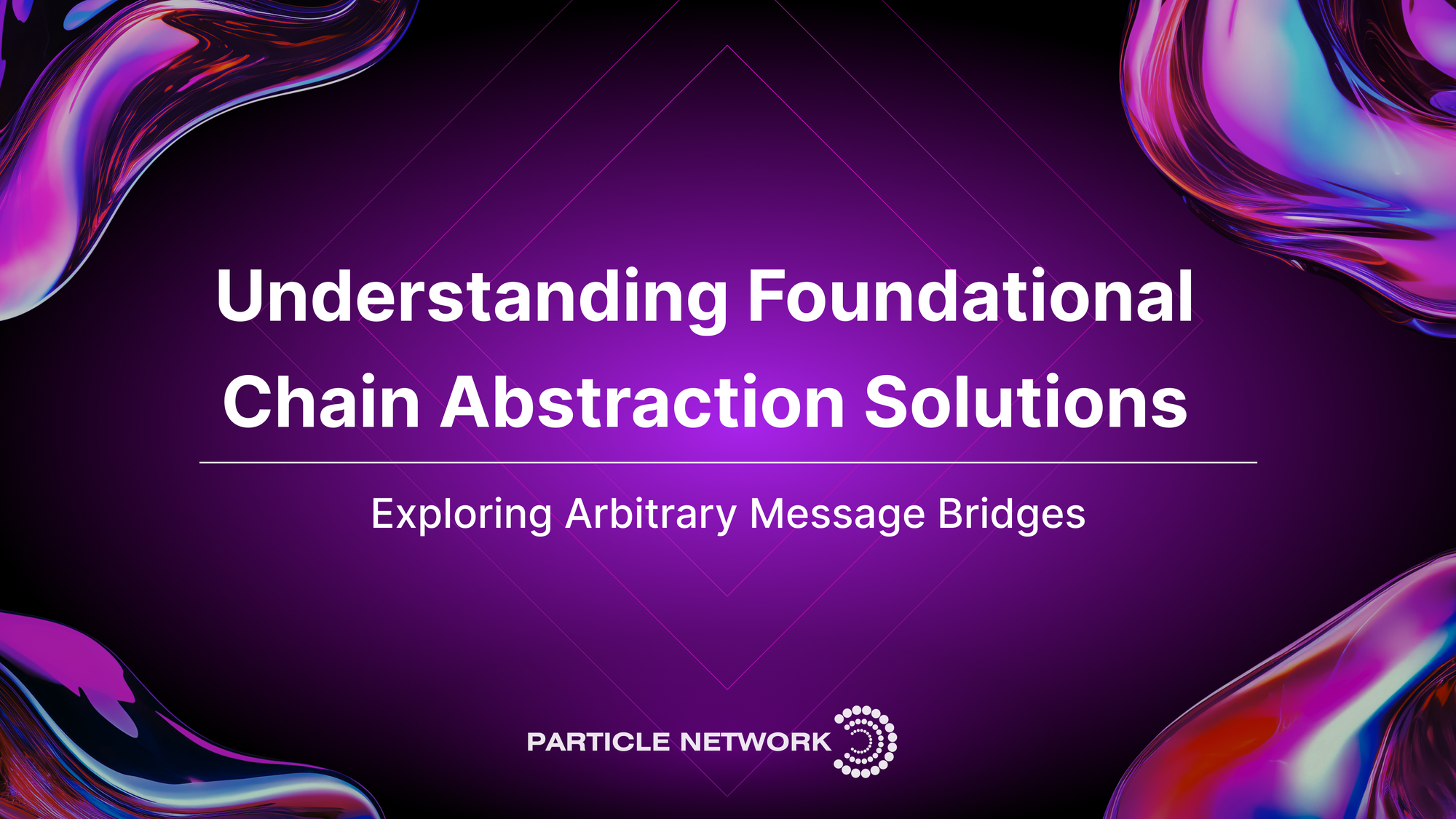Breaking Down Chain Abstraction: Foundational Solutions

Table of Contents:
Way before modular blockchains and the L2 explosion, L1 optimization was the hottest conversation in Web3.
The ecosystem assumed that a handful of networks would compete on equal terms for most of Web3’s activity. Instead, Web3 entered an era of modular expansion.
This is already yielding hundreds and, eventually, thousands of modular rollups serving dApps. Within this paradigm, applications will launch their own appchains to serve niche use cases, increasing the ecosystem’s efficiency. However, this creates an issue of its own: fragmentation.
Fragmentation can be understood in two ways:
- Technological fragmentation, resulting in siloed blockchains unable to connect or communicate.
- User and liquidity fragmentation, resulting in users’ inability to use applications across different chains without manually bridging, managing multiple balances, gas tokens, etc.
The first problem is generally reduced through message-passing solutions, which allow applications across ecosystems to communicate. To address the second one, chain abstraction has gained force as a movement dedicated to abstracting manual multi-chain interactions, providing a better UX for Web3.
This article will explore how chain abstraction can leverage Arbitrary Message Bridges (AMBs) or “foundational chain abstraction solutions” to achieve a unified experience across Web3.
Interoperability & chain abstraction: Key components of Web3’s new paradigm
Complete chain abstraction can be defined as “an experience exempt from the manual processes required to interact with multiple chains”. Such an experience is only possible once the two aforementioned problems are solved.

As mentioned, interoperability solutions, such as AMBs, act as a foundation for chain abstraction, allowing for the passing of data and commands across the ecosystem.
As such, AMBs can be considered “foundational chain abstraction solutions” due to their key role in driving two of the three primary layers of chain abstraction:
- Orchestration (application-level) solutions such as Agoric, Skip, or Socket, aim to allow developers to build applications spanning multiple chains, automatizing manual processes related to cross-chain interactions. As such, these protocols benefit from message-passing and even token bridging to build their underlying systems.
- Account-level solutions that unify liquidity for users, such as Particle Network, rely on AMBs to enable the underlying coordination needed to give users the experience of a unified balance and account across chains. In Particle’s specific case, AMBs are used to read and relay information about account states across multiple chains.
It’s worth once again pointing out that complete chain abstraction can only be conceived as an ecosystem-wide goal –rather than a technology to be developed by any one entity. Resultingly, foundational solutions serve an important role within chain abstraction even in the case of widespread adoption of blockchain-level chain abstraction, as even in this event there will still be solutions and use cases requiring the support of AMBs.
Given the above considerations, the chain abstraction stack can be represented as follows:

Next, let’s explore the intricacies of AMBs as a foundational chain abstraction solution.
Enabling chain abstraction: Arbitrary Message Bridges
As depicted above, AMBs serve as a critical foundation for all chain abstraction solutions.
In enabling this experience, not all AMBs are made equal. To fully facilitate the interoperability needed by chain abstraction, this process must be driven by solutions that contain a few key qualities:
- Decentralization and permissionlessness
An appchain-centric future means the emergence of potentially thousands of chains, meaning that interoperability between them must be permissionless. This applies across the board within the chain abstraction stack, not just to AMBs: if the interconnection and subsequent abstraction of new chains require the permission of a central authority, the aforementioned thesis becomes less viable. Tying closely into this is the need for decentralization, a requirement for security and censorship resistance. These are both non-negotiable properties of interoperability and, by extension, chain abstraction.
- Security
Strong security guarantees and transparent trust assumptions are critical for AMBs to ensure the safety of user funds and data, maintaining the integrity and reliability of cross-chain interactions. However, security is not a one-size-fits-all requirement. Different applications and chain abstraction solutions require different degrees of security and mechanisms for verifying cross-chain messages. As such, ensuring a given solution is flexible or even modular is vital for the integrity and flexibility of applications or solutions leveraging AMBs.
- Composability and standardization
For chain abstraction to thrive as a user experience/philosophy, foundational solutions need to abide by the core concept of composability, allowing their products to be interoperable with other solutions. This falls in line with Web3’s ideal of decentralized, public services and requires different use cases to interact with one another to create a comprehensive chain abstraction experience.
Permissionless solutions as a foundation for chain abstraction
From the above features, it’s important to highlight modularity and permissionlessness as core qualities for AMBs to best serve as the foundation for chain abstraction. An example of a solution featuring both qualities is Hyperlane: a highly modular interoperability protocol built to expand permissionlessly in a future with a thousand blockchains.
Hyperlane focuses on permissionlessness as a core tenet. Application and blockchain developers can deploy Hyperlane on any network, immediately connecting them to the rest of the ecosystem, enabling higher-level chain abstraction solutions to encompass all chains.
Besides the above, Hyperlane also features modular security. Different applications, chain abstraction solutions, and other implementations of AMBs require varying degrees of security, most commonly within message verification. Allowing these projects to customize their approach to security, as such, results in a more flexible approach to interconnection than providing a one-size-fits-all solution.
To further exemplify the role that interoperability solutions play within chain abstraction, we’ll focus on two chain abstraction implementations leveraging Hyperlane:
Example #1: Particle Network, enabling account-level chain abstraction through Universal Accounts
Particle’s primary product offering is Universal Accounts, which enable users to have a single balance, address, and interaction point across all chains. To make this possible, Particle relies on Universal Liquidity, an underlying system that conducts atomic cross-chain swaps to guarantee that users’ activities on different chains can pool their balances across all chains to execute as if they were all in a single network.
To guarantee the seamless execution of these transactions, Universal Liquidity automatically swaps users’ assets to tap into liquidity pools of “intermediary assets” (e.g. USDC, USDT, etc.) To fulfill users’ goals, these assets are then deposited into liquidity pools and received on the necessary chain(s), as well as swapped for any tokens their transaction requires. This process takes place automatically as soon as the user clicks the button stating their intention (e.g. “Buy NFT”, “Swap”, etc.)
The above can be diagrammed like this:

Critically, the underlying system coordinating Universal Accounts’ states across chains to guarantee that these operations are seamlessly executed and settled on the Particle Network L1 blockchain relies on Hyperlane.
Specifically, Particle Network implements Hyperlane to both query states across chains (for Universal Accounts, a type of contract) and relay cross-chain messages containing execution status or commands facilitating alterations to Universal Account state (such as signers, modules, etc.) in accordance with Particle Network’s Master Keystore Hub, as shown below:

For an implementation like Particle Network to make Universal Accounts available everywhere, Hyperlane’s permissionlessness is crucial, allowing for the ongoing and agile integration of new networks. Furthermore, Particle Network employs custom Interchain Security Modules (ISMs) to customize security (verification of cross-chain messages) depending on different scenarios. These scenarios include examples like tightening security and requiring more validity attestations whenever speed may be considered less important than high security –e.g., when synchronizing state changes for Universal Accounts or settling a high-value operation.
Example #2: Everclear, Web3’s first clearing layer
Everclear is building Web3’s first Clearing Layer, acting as a point of coordination for liquidity settlement between chains. Simply put, Everclear facilitates flexible filler/solver rebalancing across chains, efficiently routing settlements and handling (“clearing”) solver invoices. This reduces costs for both solvers and points of utilization of solvers, such as within chain abstraction protocols or bridges. As such, it aims to become the core layer responsible for settling intents (one of the most popular primitives for achieving chain abstraction) across the ecosystem.
Importantly, Everclear uses Hyperlane as its core transport layer, facilitating communication with solvers/fillers across the chains where a given intent is attempted to be executed. Alike Particle Network, two components of Hyperlane play a key role in this architecture:
- Modular security, allowing for the intent messages and communication to be verified by EigenLayer through Hyperlane’s AVS –a choice made by Everclear, possible through the implementation of an Interchain Security Module (ISM).
- Permissionless deployments on any chain, resulting in Everclear’s being able to clear solver invoices across any rollups within the ecosystem.

Modular Expansion, Modular Abstraction
Chain abstraction is an experience, not one technology.
To create a universally-applicable, decentralized, permissionless experience exempt from the manual processes required for multi-chain interaction, a stack of composable technologies is a must. Such a stack necessarily starts with interoperability solutions, making them the foundation for chain abstraction.
Particle Network's Chain Abstraction solutions are 100% free for developers and teams. By integrating them, you can set your project in a path to leveraging chain abstraction.
About Particle Network

Particle Network powers chain abstraction, addressing Web3's fragmentation of users and liquidity. This is enabled by Particle's Universal Accounts, which give users a unified account and balance across all chains.
Share this article
About the author(s)


